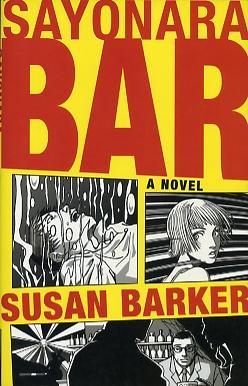Kanto thrills and Kansai fantasies
Murders at Kamakura Inn and hoods at Sayonara Bar
By Mark Schreiber
A version of this review appeared as
"Summertime, and the dying is easy" in
The Japan Times, The Asian Bookshelf, 20 August 2006
Marshall Browne, Rendezvous at Kamakura Inn, 2005
Susan Barker, Sayonara Bar, 2006

Marshall Browne For Detective Inspector Hideo Aoki of the Tokyo Metropolitan Police, the sprinklings of misfortune have become a torrential downpour. His exhaustive efforts to indict a powerful politician have been aborted by his superiors, and his investigative team disbanded. His father dies, and soon afterward his wife hangs herself. A cop away from homeOstensibly for compassionate leave, Aoki's boss reserves him a stay at an isolated hot spring which, title notwithstanding, is in a remote part of Hokkaido. Upon arrival, Aoki finds himself in an exceedingly peculiar situation. A woman had mysteriously disappeared in Tokyo seven years ago to the day, and her husband, a corrupt banker, and her former paramour, a finance ministry official, both happen to be staying at the same inn, which by another remarkable coincidence is managed by the woman's daughter. An unseasonable blizzard hits, telephone communications and electric power fail, and as the darkness sets in, hotel guests' heads start rolling in quick succession. Aoki, not only out of his official jurisdiction but also minus his service revolver and badge, is forced to match wits with a melange of suspicious characters, including an enigmatic player of the board game Go. Christie-like developmentAs this contrived situation develops, Aoki encounters a series of deaths by foul play -- reminiscent of Agatha Christie's classic Ten Little Niggers (1939) -- better known outside the United Kingdom as And Then There Were None (1940), or as Ten Little Indians in several stage and film adaptations. The development also bears some resemblance to Washington, D.C. denizen Lewis "Scooter" Libby's bizarre 1996 tale The Apprentice (reviewed in Asian Bookshelf in January 2006). Aoki, the long-suffering cop, ultimately prevails; but his triumph comes about neither through astute detection nor through dogged determination. Nor, for that matter, through dauntless courage. He just assumes the role of judge, jury and executioner and terminates the bad guys like a Japanese version of Dirty Harry Callahan. The wicked may indeed get their just deserts, but disappointingly, justice is not served. Marshall Browne -- one of Australia's most accomplished mystery authors -- cites Yasunari Kawabata's The Master of Go as one of his sources. But his efforts to work the game into the story contribute little to the narrative. Kawabata aside, Rendezvous at Kamakura Inn approaches murder in Japan at a variety of levels and fails at almost all of them. |

Susan Barker The garish yellow, manga-style cover of Sayonara Bar may repel some readers, but the story, narrated in the first person by three different characters, is quite entertaining. First there's Mary, a British gal working as a hostess at the Sayonara Bar; Watanabe, a brilliant but delusional young man with a crush on Mary, who works as the bar's cook; and Mr. Sato, a lonely, depressed widower and corporate drone who is reluctantly dragged to the bar by a superior. A semblance of normalityBarker's tale somewhat resembles Mo Hayder's Tokyo (reviewed in Asian Bookshelf in May 2004). Both are web-work stories featuring British women in the Japanese water trade; both involve violent encounters with menacing Japanese hoods; and both convey an aura of gothic weirdness.The Hayder story, however, jumped between the present and flashbacks to Nanjing in the 1930s, and its characters were grotesque. With Susan Barker's story, at least, two out of three characters show a semblance of normality and until things start to become unraveled, Sato's life contains no surprises. A day at the officeAs Sato himself relates:
Enter MarikoSato's office solitude is rudely interrupted by Mariko, a teenage girl who works as a part-time waitress at Sayonara Bar, and who suddenly approaches his desk with a boxed meal she had prepared for him. Although Mariko appears naive and innocent, her deceptive acts toward the grieving widower are crueler than anything the local yakuza threaten to do to the other two characters. Chimera-like in its progression, Sayonara Bar metamorphoses between crime story, elements of SF fantasy and social commentary, providing an original if somewhat squalid look at the dark underside of life in Kansai. |